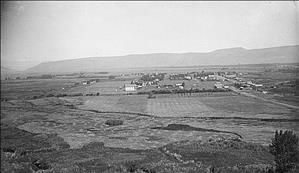On September 22, 1909, Valleys of the Yakima Day, Blaine Day, and Calgary Day are celebrated at the Alaska-Yukon-Pacific Exposition in Seattle. The A-Y-P Exposition took place on the University of Washington campus in Seattle between June 1 and October 16, 1909, drawing more than three million people. Visitors came from around the state, the nation, and the world to view hundreds of educational exhibits, stroll the lushly manicured grounds, and be entertained on the Pay Streak midway, while Seattle promoted itself as a gateway to the rich resources of Alaska, the Yukon, and Asia. Each day of the A-Y-P was designated as a Special Day for one or more groups. Special Days drew people involved in the featured organizations, and the resulting programs, lectures, ceremonies, parades, and athletic competitions gave local people a reason to visit again and again. Blaine Day and Calgary Day are informal celebrations with no special activities planned. Instead, the spotlight is on Valleys of the Yakima Day, which begins with a parade through the fairgrounds, led by three bands; the day’s exercises follow in the Auditorium. The afternoon is given over to sightseeing at the fair, and the day concludes with a fireworks show at the foot of the Pay Streak featuring the giant red apples of the Yakima valleys.
Jolly Ranchers
About 2,000 happy ranchers and their families from three Washington state counties -- Benton, Kittitas, and Yakima -- descended on Seattle on September 22, 1909, to celebrate Valleys of the Yakima Day at the A-Y-P. Disappointed by low turnout for Yakima County Day at the exposition in June and determined that it wouldn’t happen again, North Yakima (today known as Yakima) alone sent at least 500 townspeople, more than the entire total that had attended Yakima County Day. W. P. Romans, representing the local arrangements committee, also visited commercial clubs in North Yakima, Prosser, Ellensburg, and other valley cities, exhorting citizens to come to the fair, and come they did: Ellensburg, Granger, Hanford, Kiona, Mabton, North Yakima, Prosser, Sunnyside, Toppenish, and Wapato were all represented.
Most of the visitors from the valleys had already seen the fair during the summer, but that mattered not at all as they happily assembled at 8:45 a.m. at Pioneer Square, boarding streetcars festooned with banners reading “Valleys of the Yakima.” The group, some wearing badges or carrying small pennants identifying them as representing the Yakima valleys, took the scenic route to the fair. Arriving shortly after 10:30 a.m., they formed a parade at the main gate and marched to the Auditorium, led by not one but three bands: one from Sunnyside, one from Mabton or Prosser (accounts differ), and everybody’s favorite, Nagler’s Juvenile Band, which had been such a hit at Yakima County Day. (This North Yakima band was made up of 42 boys between the ages of 8 and 15.)
At 11 a.m. the day’s exercises commenced in the Auditorium. Josiah Collins, chairman of the exposition committee of ceremonies, gave a brief welcome. U.S. Senator Wesley Jones (1863-1932) responded, describing the nirvana of the valleys of the Yakima and praising the exposition for doing “much good” for the valleys. Judge C. H. Hanford (1849-1926) followed with a speech, and U.S. Senator Samuel Piles (1858-1940) gave the final oratory. Perhaps sensing that his audience was eager to see the fair, Piles kept his remarks mercifully short, declaring that “it would be cruelty on his part to keep the audience listening to him, while they wanted to see the fair” (“Apple County Sends a Throng”).
By 1 p.m. the speeches were over and the crowd dispersed to enjoy the fair. The three bands spent the afternoon exploring the fairgrounds and playing at selected sites; the remaining attendees had more freedom to do as they pleased and wandered the fairgrounds. Some of them checked out a free irrigation demonstration at the Yakima County Building. More of them took advantage of two different apple giveaways, one at the Yakima County Building and another at the Benton and Kittitas County booths in the Agricultural Building. The day ended with special fireworks show at the foot of the Pay Streak at 9 p.m., which included set pieces representing the big red apples of the Yakima valleys.
Other Special Days
Border-town Blaine and Calgary, Alberta, also celebrated their special days at the fair on September 22, 1909. There were no special activities planned to mark either day, and, judging by the lack of press coverage, it appears that these two days were informal and quiet.
But this was probably a good thing for the Calgarians. The preceding day had been Edmonton (Alberta) Day, but signs and placards placed all around the fair had heralded “Edmonton, B.C. [British Columbia] Day,” infuriating the Albertans, particularly since Edmonton was (and is) their capital. Presumably the province of Alberta was properly recognized for Calgary Day.

